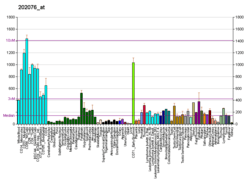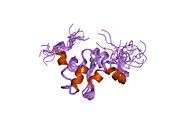Baculoviral IAP repeat-containing protein 2
Baculoviral IAP repeat-containing protein 2 (also known as cIAP1) is a protein that in humans is encoded by the BIRC2 gene.[5][6]
Function
cIAP1 is a member of the Inhibitor of Apoptosis family that inhibit apoptosis by interfering with the activation of caspases.
Interactions
BIRC2 has been shown to interact with:
References
- 1 2 3 GRCh38: Ensembl release 89: ENSG00000110330 - Ensembl, May 2017
- 1 2 3 GRCm38: Ensembl release 89: ENSMUSG00000057367 - Ensembl, May 2017
- ↑ "Human PubMed Reference:".
- ↑ "Mouse PubMed Reference:".
- ↑ Liston P, Roy N, Tamai K, Lefebvre C, Baird S, Cherton-Horvat G, Farahani R, McLean M, Ikeda JE, MacKenzie A, Korneluk RG (February 1996). "Suppression of apoptosis in mammalian cells by NAIP and a related family of IAP genes". Nature. 379 (6563): 349–53. doi:10.1038/379349a0. PMID 8552191.
- ↑ Rothe M, Pan MG, Henzel WJ, Ayres TM, Goeddel DV (February 1996). "The TNFR2-TRAF signaling complex contains two novel proteins related to baculoviral inhibitor of apoptosis proteins". Cell. 83 (7): 1243–52. doi:10.1016/0092-8674(95)90149-3. PMID 8548810.
- ↑ Deveraux QL, Roy N, Stennicke HR, Van Arsdale T, Zhou Q, Srinivasula SM, Alnemri ES, Salvesen GS, Reed JC (1998). "IAPs block apoptotic events induced by caspase-8 and cytochrome c by direct inhibition of distinct caspases". EMBO J. 17 (8): 2215–23. doi:10.1093/emboj/17.8.2215. PMC 1170566. PMID 9545235.
- 1 2 3 Hegde R, Srinivasula SM, Datta P, Madesh M, Wassell R, Zhang Z, Cheong N, Nejmeh J, Fernandes-Alnemri T, Hoshino S, Alnemri ES (2003). "The polypeptide chain-releasing factor GSPT1/eRF3 is proteolytically processed into an IAP-binding protein". J. Biol. Chem. 278 (40): 38699–706. doi:10.1074/jbc.M303179200. PMID 12865429.
- ↑ Verhagen AM, Ekert PG, Pakusch M, Silke J, Connolly LM, Reid GE, Moritz RL, Simpson RJ, Vaux DL (2000). "Identification of DIABLO, a mammalian protein that promotes apoptosis by binding to and antagonizing IAP proteins". Cell. 102 (1): 43–53. doi:10.1016/S0092-8674(00)00009-X. PMID 10929712.
- 1 2 Didelot C, Lanneau D, Brunet M, Bouchot A, Cartier J, Jacquel A, Ducoroy P, Cathelin S, Decologne N, Chiosis G, Dubrez-Daloz L, Solary E, Garrido C (2008). "Interaction of heat-shock protein 90 beta isoform (HSP90 beta) with cellular inhibitor of apoptosis 1 (c-IAP1) is required for cell differentiation". Cell Death Differ. 15 (5): 859–66. doi:10.1038/cdd.2008.5. PMID 18239673.
- ↑ Verhagen AM, Silke J, Ekert PG, Pakusch M, Kaufmann H, Connolly LM, Day CL, Tikoo A, Burke R, Wrobel C, Moritz RL, Simpson RJ, Vaux DL (2002). "HtrA2 promotes cell death through its serine protease activity and its ability to antagonize inhibitor of apoptosis proteins". J. Biol. Chem. 277 (1): 445–54. doi:10.1074/jbc.M109891200. PMID 11604410.
- 1 2 Bertrand MJ, Milutinovic S, Dickson KM, Ho WC, Boudreault A, Durkin J, Gillard JW, Jaquith JB, Morris SJ, Barker PA (2008). "cIAP1 and cIAP2 facilitate cancer cell survival by functioning as E3 ligases that promote RIP1 ubiquitination". Mol. Cell. 30 (6): 689–700. doi:10.1016/j.molcel.2008.05.014. PMID 18570872.
- ↑ McCarthy JV, Ni J, Dixit VM (1998). "RIP2 is a novel NF-kappaB-activating and cell death-inducing kinase". J. Biol. Chem. 273 (27): 16968–75. doi:10.1074/jbc.273.27.16968. PMID 9642260.
- ↑ Thome M, Hofmann K, Burns K, Martinon F, Bodmer JL, Mattmann C, Tschopp J (1998). "Identification of CARDIAK, a RIP-like kinase that associates with caspase-1". Curr. Biol. 8 (15): 885–8. doi:10.1016/S0960-9822(07)00352-1. PMID 9705938.
- ↑ Kuai J, Nickbarg E, Wooters J, Qiu Y, Wang J, Lin LL (2003). "Endogenous association of TRAF2, TRAF3, cIAP1, and Smac with lymphotoxin beta receptor reveals a novel mechanism of apoptosis". J. Biol. Chem. 278 (16): 14363–9. doi:10.1074/jbc.M208672200. PMID 12571250.
- 1 2 Roy N, Deveraux QL, Takahashi R, Salvesen GS, Reed JC (1997). "The c-IAP-1 and c-IAP-2 proteins are direct inhibitors of specific caspases". EMBO J. 16 (23): 6914–25. doi:10.1093/emboj/16.23.6914. PMC 1170295. PMID 9384571.
- 1 2 Shu HB, Takeuchi M, Goeddel DV (1996). "The tumor necrosis factor receptor 2 signal transducers TRAF2 and c-IAP1 are components of the tumor necrosis factor receptor 1 signaling complex". Proc. Natl. Acad. Sci. U.S.A. 93 (24): 13973–8. doi:10.1073/pnas.93.24.13973. PMC 19479. PMID 8943045.
- 1 2 Li X, Yang Y, Ashwell JD (2002). "TNF-RII and c-IAP1 mediate ubiquitination and degradation of TRAF2". Nature. 416 (6878): 345–7. doi:10.1038/416345a. PMID 11907583.
- ↑ Rual JF, Venkatesan K, Hao T, Hirozane-Kishikawa T, Dricot A, Li N, Berriz GF, Gibbons FD, Dreze M, Ayivi-Guedehoussou N, Klitgord N, Simon C, Boxem M, Milstein S, Rosenberg J, Goldberg DS, Zhang LV, Wong SL, Franklin G, Li S, Albala JS, Lim J, Fraughton C, Llamosas E, Cevik S, Bex C, Lamesch P, Sikorski RS, Vandenhaute J, Zoghbi HY, Smolyar A, Bosak S, Sequerra R, Doucette-Stamm L, Cusick ME, Hill DE, Roth FP, Vidal M (2005). "Towards a proteome-scale map of the human protein-protein interaction network". Nature. 437 (7062): 1173–8. doi:10.1038/nature04209. PMID 16189514.
- ↑ Uren AG, Pakusch M, Hawkins CJ, Puls KL, Vaux DL (1996). "Cloning and expression of apoptosis inhibitory protein homologs that function to inhibit apoptosis and/or bind tumor necrosis factor receptor-associated factors". Proc. Natl. Acad. Sci. U.S.A. 93 (10): 4974–8. doi:10.1073/pnas.93.10.4974. PMC 39390. PMID 8643514.
- ↑ Yoneda T, Imaizumi K, Maeda M, Yui D, Manabe T, Katayama T, Sato N, Gomi F, Morihara T, Mori Y, Miyoshi K, Hitomi J, Ugawa S, Yamada S, Okabe M, Tohyama M (2000). "Regulatory mechanisms of TRAF2-mediated signal transduction by Bcl10, a MALT lymphoma-associated protein". J. Biol. Chem. 275 (15): 11114–20. doi:10.1074/jbc.275.15.11114. PMID 10753917.
- ↑ Sekine K, Takubo K, Kikuchi R, Nishimoto M, Kitagawa M, Abe F, Nishikawa K, Tsuruo T, Naito M (2008). "Small molecules destabilize cIAP1 by activating auto-ubiquitylation". J. Biol. Chem. 283 (14): 8961–8. doi:10.1074/jbc.M709525200. PMID 18230607.
Further reading
- Maruyama K, Sugano S (1994). "Oligo-capping: a simple method to replace the cap structure of eukaryotic mRNAs with oligoribonucleotides". Gene. 138 (1–2): 171–4. doi:10.1016/0378-1119(94)90802-8. PMID 8125298.
- Uren AG, Pakusch M, Hawkins CJ, Puls KL, Vaux DL (1996). "Cloning and expression of apoptosis inhibitory protein homologs that function to inhibit apoptosis and/or bind tumor necrosis factor receptor-associated factors". Proc. Natl. Acad. Sci. U.S.A. 93 (10): 4974–8. doi:10.1073/pnas.93.10.4974. PMC 39390. PMID 8643514.
- Rajcan-Separovic E, Liston P, Lefebvre C, Korneluk RG (1997). "Assignment of human inhibitor of apoptosis protein (IAP) genes xiap, hiap-1, and hiap-2 to chromosomes Xq25 and 11q22-q23 by fluorescence in situ hybridization". Genomics. 37 (3): 404–6. doi:10.1006/geno.1996.0579. PMID 8938457.
- Shu HB, Takeuchi M, Goeddel DV (1997). "The tumor necrosis factor receptor 2 signal transducers TRAF2 and c-IAP1 are components of the tumor necrosis factor receptor 1 signaling complex". Proc. Natl. Acad. Sci. U.S.A. 93 (24): 13973–8. doi:10.1073/pnas.93.24.13973. PMC 19479. PMID 8943045.
- Suzuki Y, Yoshitomo-Nakagawa K, Maruyama K, Suyama A, Sugano S (1997). "Construction and characterization of a full length-enriched and a 5'-end-enriched cDNA library". Gene. 200 (1–2): 149–56. doi:10.1016/S0378-1119(97)00411-3. PMID 9373149.
- Roy N, Deveraux QL, Takahashi R, Salvesen GS, Reed JC (1998). "The c-IAP-1 and c-IAP-2 proteins are direct inhibitors of specific caspases". EMBO J. 16 (23): 6914–25. doi:10.1093/emboj/16.23.6914. PMC 1170295. PMID 9384571.
- Deveraux QL, Roy N, Stennicke HR, Van Arsdale T, Zhou Q, Srinivasula SM, Alnemri ES, Salvesen GS, Reed JC (1998). "IAPs block apoptotic events induced by caspase-8 and cytochrome c by direct inhibition of distinct caspases". EMBO J. 17 (8): 2215–23. doi:10.1093/emboj/17.8.2215. PMC 1170566. PMID 9545235.
- McCarthy JV, Ni J, Dixit VM (1998). "RIP2 is a novel NF-kappaB-activating and cell death-inducing kinase". J. Biol. Chem. 273 (27): 16968–75. doi:10.1074/jbc.273.27.16968. PMID 9642260.
- Young SS, Liston P, Xuan JY, McRoberts C, Lefebvre CA, Korneluk RG (1999). "Genomic organization and physical map of the human inhibitors of apoptosis: HIAP1 and HIAP2". Mamm. Genome. 10 (1): 44–8. doi:10.1007/s003359900940. PMID 9892732.
- Hinds MG, Norton RS, Vaux DL, Day CL (1999). "Solution structure of a baculoviral inhibitor of apoptosis (IAP) repeat". Nat. Struct. Biol. 6 (7): 648–51. doi:10.1038/10701. PMID 10404221.
- Verhagen AM, Ekert PG, Pakusch M, Silke J, Connolly LM, Reid GE, Moritz RL, Simpson RJ, Vaux DL (2000). "Identification of DIABLO, a mammalian protein that promotes apoptosis by binding to and antagonizing IAP proteins". Cell. 102 (1): 43–53. doi:10.1016/S0092-8674(00)00009-X. PMID 10929712.
- Vucic D, Stennicke HR, Pisabarro MT, Salvesen GS, Dixit VM (2001). "ML-IAP, a novel inhibitor of apoptosis that is preferentially expressed in human melanomas". Curr. Biol. 10 (21): 1359–66. doi:10.1016/S0960-9822(00)00781-8. PMID 11084335.
- Werneburg BG, Zoog SJ, Dang TT, Kehry MR, Crute JJ (2001). "Molecular characterization of CD40 signaling intermediates". J. Biol. Chem. 276 (46): 43334–42. doi:10.1074/jbc.M104994200. PMID 11562359.
- Suzuki Y, Imai Y, Nakayama H, Takahashi K, Takio K, Takahashi R (2001). "A serine protease, HtrA2, is released from the mitochondria and interacts with XIAP, inducing cell death". Mol. Cell. 8 (3): 613–21. doi:10.1016/S1097-2765(01)00341-0. PMID 11583623.
- Verhagen AM, Silke J, Ekert PG, Pakusch M, Kaufmann H, Connolly LM, Day CL, Tikoo A, Burke R, Wrobel C, Moritz RL, Simpson RJ, Vaux DL (2002). "HtrA2 promotes cell death through its serine protease activity and its ability to antagonize inhibitor of apoptosis proteins". J. Biol. Chem. 277 (1): 445–54. doi:10.1074/jbc.M109891200. PMID 11604410.
- Mellström B, Ceña V, Lamas M, Perales C, Gonzalez C, Naranjo JR (2002). "Gas1 is induced during and participates in excitotoxic neuronal death". Mol. Cell. Neurosci. 19 (3): 417–29. doi:10.1006/mcne.2001.1092. PMID 11906213.
- Li X, Yang Y, Ashwell JD (2002). "TNF-RII and c-IAP1 mediate ubiquitination and degradation of TRAF2". Nature. 416 (6878): 345–7. doi:10.1038/416345a. PMID 11907583.
- Imoto I, Tsuda H, Hirasawa A, Miura M, Sakamoto M, Hirohashi S, Inazawa J (2002). "Expression of cIAP1, a target for 11q22 amplification, correlates with resistance of cervical cancers to radiotherapy". Cancer Res. 62 (17): 4860–6. PMID 12208731.
External links
- Human BIRC2 genome location and BIRC2 gene details page in the UCSC Genome Browser.
This article is issued from
Wikipedia.
The text is licensed under Creative Commons - Attribution - Sharealike.
Additional terms may apply for the media files.






